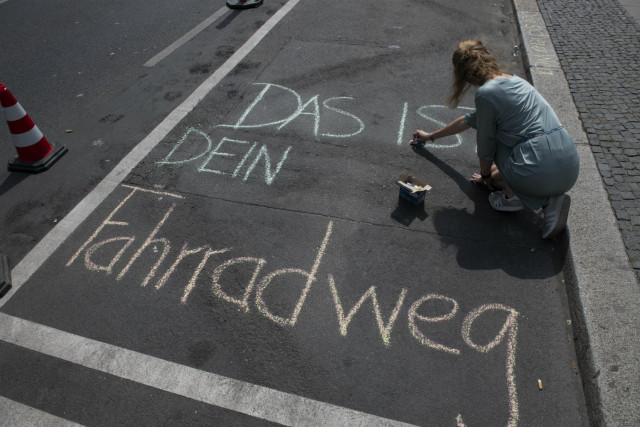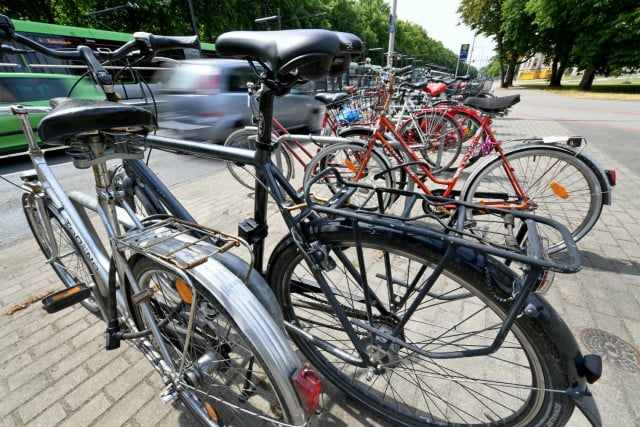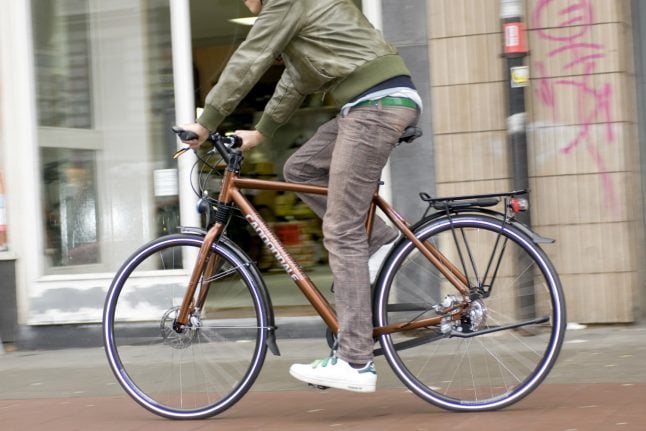Germany is a “car-country” – but could it be a “bike-nation”? The journey would be a long one. So far, most city spaces still belong to the car.
Cycling on busy roads without bike paths is often dangerous, since parked vehicles obstruct bike and pedestrian lanes. The car industry is a key economic player in Germany and has a strong lobby.
Cycling, on the other hand, was neglected for decades, according to the Allgemeine Deutsche Fahrrad-Club (General German Biking Club, or ADFC).
But now it seems attitudes are changing, and the main factor behind the push is climate protection. The ADFC celebrated its 40th anniversary with a symposium Friday in Berlin.
Transport Minister Andreas Scheuer (CSU), a self-proclaimed Fahrradminister, or “Pro-Bicycle Minister,” will address the question: What is the state of cycling in Germany?
Here's what we know so far.
Preventing accidents
Cyclists often live dangerously on German roads. According to information from the Federal Statistics Office, 275 cyclists were killed in traffic accidents between January and July 2019: 16 more than in the same period of the previous year.
This is an increase of 6.2 percent, with slightly fewer traffic accidents and fewer fatalities overall.
READ ALSO: 'We must expand cycling infrastructure': Biking fatalities rise in Germany
The same types of accidents are seen again and again as truck drivers, usually seated high above the flow of traffic, overlook cyclists or pedestrians in their blind spots.
Some propose assisted steering software that can emit warning signals or brake automatically.
'Equal road users'
It’s no coincidence the ADFC has named its anniversary campaign #MehrPlatzFürsRad, or #MoreSpaceforBikes; This is considered the core issue. Helmut Dedy, the Managing Director of the Deutscher Städtetag (German Association of Cities) says streets and public squares should be “more than just a parking lot and a lane for cars.”
The idea is to divide public space more equitably for all involved. According to information from the German Ministry of Transport, around 11 percent of all trips are currently made by bicycle, with numbers substantially higher in the cities.
“We want to significantly increase this share in the coming years,” says Dedy.
However, a good cycling infrastructure must be in place if Germany wants to make the switch to more bicycles, and is the key to make cycling comfortable and safe. Bottom line: bicycles need more space.
“Cyclists are equal road users on the street,” says Scheuer. “They not only need more acceptance, but above all, more space.”

Activists in Berlin use chalk to re-label parking spots as biking paths to support a cycling-friendly city. Photo: DPA
Investing in infrastructure
Billions of euros have flowed into the construction and maintenance of roads for decades, as well as into the railways. This will be no different in next year's budget, but funding for cycling improvements is going up.
Currently, the Ministry of Transport is providing €200 million in federal funding to promote bicycle lanes on federal highways and bicycle-only paths. However, states, districts and municipalities are responsible for the construction and maintenance of all other cycle paths.
But now there should be a big chunk more money: The government's climate protection program will provide an additional €900 million through the year 2023 to promote the founding of new infrastructure projects in the states and municipalities.
This would mean that €1.45 billion would be available at the federal level just for cycling by 2023.
READ ALSO: What does Germany's planned climate protection package mean for you
“The goal is a fairer division of the road space and the most complete and secure cycling infrastructure possible,” Scheuer says.
The Association of Cities is calling for an “aggressive cycling initiative” supported by federal, state and local authorities.
“There are a few things underway, but there is still much to do,” said Dedy. Bike-only lanes must be expanded so that they offer a real alternative to cars and to better connect cities with the surrounding areas.”
The ADFC has been calling for more funding for a long time. “Germany has to make up more than 30 years of stagnation in the development of bicycle infrastructure – and that's a pretty big undertaking,” says spokesperson Stephanie Krone.
The biggest challenge is that city planners specialized in cycling infrastructure and the corresponding consulting firms were missing.
“In the Netherlands and Denmark, the construction of wide, continuous bike paths and safe crossings has a long tradition. In Germany, this is technically still new territory.”

Bicycles are locked up by the roadside in the city of Hanover, Lower Saxony. Photo: DPA
Fines for parking on footpaths
The conclusion: Cycling will likely become safer in the coming years, with more space and more rights for cyclists and stricter rules for cars. The Federal Cabinet recently approved some of Scheuer’s proposals, but the states have yet to sign on.
Under these new regulations, the fines for parking on footpaths and bike paths would rise. Additionally, there will be more zones with speed limits of 30 kilometres per hour for all transport, keeping cyclists safe more broadly. There are also plans for right-turn signals specifically for cyclists.
Bicycles on the rails
Cycling to the train station and hopping on with your bicycle to shorten the ride is a nice idea, but the implementation is lagging. For one thing, there are too few bicycle parking spots at stations in major cities. And bringing a bike on the train is difficult so far.
That should improve. By 2025, bicycle places in trains, while not available on every single stretch, will at least be offered on every long-distance train.
How bike friendly is Germany?
Compared to other countries in Europe, the verdict on Germany's cycling culture is sobering.
“People in Germany would like to ride more bicycles, but the conditions on the roads are often scary,” said ADFC spokeswoman Krone. “We must first become a bicycle-friendly nation.”
The Association of Cities says Germany is almost a “developing country when it comes to bicycles.”
Green Transport politician Stefan Gelbhaar was even more explicit: “Cycling in Germany is still at the Holzklasseniveau (a term for lower-class).”
This becomes especially clear when you compare cycling in the Netherlands or in Denmark. “There is a lot of catching up to do.”



 Please whitelist us to continue reading.
Please whitelist us to continue reading.
Member comments